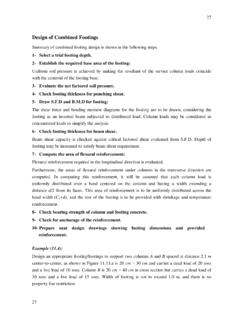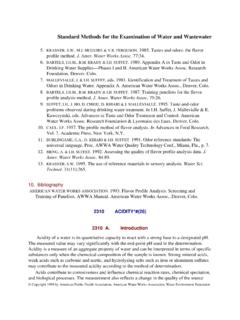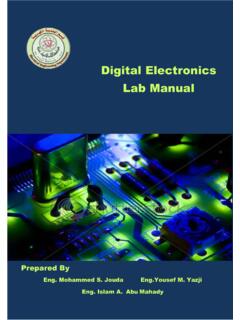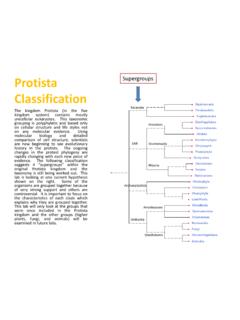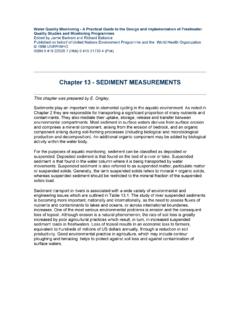Transcription of 3. Taxonomy and classification of Algae
1 3. Taxonomy and classification of Algae Taxonomy (Greek, "organizing rules") is the science of naming, describing and classifying the organisms into similar groups. The formal classification scheme in use today consists of a series of 7 major categories or taxa (singular, taxon). We place organisms in these taxa based on their similarities, then group similar taxa into larger and larger groupings. The basic structure of classification currently used is as follows: KINGDOM PHYLUM (DIVISION) CLASS ORDER FAMILY GENUS SPECIES (A good acronym for remembering the above order of classification is: "Kings Play Chess On Fine Green Sand") Most biologists divide the living world into five "Kingdoms". These Kingdoms are: 1. Kingdom Monera 2. Kingdom Protista 3. Kingdom Fungi 4. Kingdom Plantae 5. Kingdom Animalia Principles of algal classification Although quite simple in form, the Algae are an extremely diverse group. They vary in size from the minute (1-5 m) to the very large species such as kelp, known to grow to 50 m or more in length.
2 Depending on methodology and philosophy, taxonomists suggest there are between 50,000 and 10 million different algal species No easily definable classification system acceptable to all exists for Algae because algal Taxonomy and systematics is under constant discussion and change, even more after introduction of molecular techniques The history of algal classification went from morphology to ultrastructure to genomic analyes; sometimes genetic and morphological classifications contradict Sometimes morphology can mislead when one species exhibits several "growth forms", dependent on environmental conditions: The major groups of Algae have been classified into Divisions (the equivalent taxon in the zoological code was the Phylum). The standard botanical classification system is used in the systematics of the Algae : Phylum (Division) phyta Class phyceae Order ales Family aceae Genus Species 31 The current systems of classification of Algae are based on the following main criteria: o kinds of photosynthetic pigments, o type or chemical nature of photosynthetic energy storage products o photosynthetic membranes (thylakoids) organization and other features of the chloroplasts.
3 O cell wall composition and structure. o the presence or absence of flagella (as well as the number and placement of these flagella, when present). o ultrastructure of the flagella (if any), o scheme and path of nuclear and cell division, o sexual cycles. o presence of an envelope of endoplasmic reticulum around the chloroplast (see below) o possible connection between the endoplasmic reticulum and the nuclear membrane. o Recently, studies compare the sequence of macromolecules genes and the 5S, 18S, and 28S ribosomal RNA sequences o occurrence of any other special features, Table attempts to summarize the main characteristics of the different algal divisions. 32 Based on type of the cell, Algae can be grouped basically into two major assemblages prokaryotic and eukaryotic Algae There are four distinct groups within the Algae Group 1 Prokaryotic Algae include two divisions: Cyanobacteria and Group 2 Eukaryotic Algae with chloroplasts surrounded only by the two membranes of the chloroplast envelope and includes mainly two divisions; Rhodophyta and Chlorophyta.
4 The Glaucophyta represent an intermediate position in the evolution of chloroplasts; photosynthesis is carried out by modified endosymbiotic cyanobacteria. Group 3 Eukaryotic Algae with chloroplasts surrounded by one membrane of chloroplast endoplasmic reticulum and include two divisions; Dinophyta and Euglenophyta. Group 4 Eukaryotic Algae with chloroplasts surrounded by two membranes of chloroplast endoplasmic reticulum and include four divisions; Heterokontophyta, Haptophyta, Cryptophyta and Chlorarachniophyta. A summary of the classification Scheme of the Different Algal Groups is shown in Table 33 Table Predominant photosynthetic pigments, storage products and cell wall components for the major algal groups. 34 GENERAL DESCRIPTION OF MAJOR DIVISIONS AND CLASSES PROKARYOTES CYANOPHYTA (BLUE-GREEN Algae ) AND PROCHLOROPHYTA - All blue-green Algae (Figure ) and prochlorophytes (Figure ) are non-motile Gram negative eubacteria.
5 - Unicellular, colonies, filaments - They lack a nucleus and organelles (chloroplast, mitochondria). - Circular DNA, no chromosomes, no histone protein - 70S ribosomes smaller than eukaryotic - Both contain polyhedral bodies (carboxysomes) containing RuBisCo (ribulose bisphospate carboxylase/oxygenase, the enzyme that converts inorganic carbon to reduced organic carbon in all oxygen evolving photosynthetic organisms), - cell walls characterized by a peptidoglycan layer. - classified as obligate photoautotrophic organisms. - Reproduction is strictly asexual, by simple cell division or fragmentation of the colony or filaments. FIGURE Trichome of Arthrospira sp. (Bar: 20 m.) FIGURE Cells of Prochloron sp. (Bar: 10 m.) Cyanophyta In structural diversity, blue-green Algae range from unicells through branched and unbranched filaments to unspecialized colonial aggregations which are surrounded by a firm or amorphous mucilage They are possibly the most widely distributed of any group of Algae and inhabit marine and freshwater environments, moist soils and rocks, either as freeliving or as symbiotic organisms.
6 Some planktonic forms can float owing to the presence of gas vacuoles, and most of the filamentous forms have gliding motility. Numerically these organisms dominate the ocean ecosystems. There are approximately 1024 cyanobacterial cells in the oceans. To put that in perspective, the number of cyanobacterial cells in the oceans is two orders of magnitude more than all the stars in the sky. 35 Pigmentation of cyanobacteria includes chlorophyll a, blue and red phycobilins (phycoerythrin, phycocyanin, allophycocyanin, and phycoerythrocyanin), carotenoids and xanthophylls. These accessory pigments lie in the phycobilisomes, located in rows on the outer surface of the thylakoids. The traditional name of blue-green Algae for the Cyanophyceae is due to the presence of phycocyanin and phycoerythrin, which usually mask the chlorophyll pigmentation. Their thylakoids, which lie free in the cytoplasm, are not arranged in stacks, but singled and equidistant, in contrast to prochlorophytes and most other Algae , but similar to Rhodopyta and Glaucophyta.
7 The reserve polysaccharide is cyanophycean starch, stored in tiny granules lying between the thylakoids. In addition, these cells often contain cyanophycin granules, that is, polymer of arginine and asparagine. Some marine species contain gas vesicles used for buoyancy regulation. In some filamentous cyanobacteria, heterocysts and akinetes are formed. Heterocysts (Figure ) are vegetative cells (though they are larger) that appear empty in the light microscope (whereas akinetes appear full of storage products). Heterocysts have been drastically altered to provide the necessary anoxygenic environment which is ideal for nitrogenase enzyme necessary for the process of nitrogen fixation as following:. o They are photosynthetically inactive because they loss of photosystem II thus they do not fix CO2, nor do they produce O2. o They also exhibit a high rate of respiratory O2 consumption o They are surrounded by a thick, laminated, glycolipid cell wall that limits ingress of atmospheric gases, including O2.
8 O Heterocysts are formed at regular intervals from vegetative cells by the dissolution of storage granules, the deposition of a multilayered envelope outside of the cell wall, the breakdown of photosynthetic thylakoids, and the formation of new membranous structures Some cyanobacteria produce potent hepatotoxin and neurotoxins. FIGURE Light micrograph of Anabaena crassa showing vegetative cells, akinetes, and heterocysts. Cyanobacteria Systematics Based on growth form and presence/abscence of morphological features: 5 groups (order) o Unicelluar (rods or cocci) - Synechococcus o Pleurocapsalean - unicells which produce endospores - Dermocarpa o Non-heterocystous filaments - Spirulina, Oscillatoria, Trichodesmium o Heterocystous unbranched filaments - Anabaena, Nostoc o Heterocystous branched filaments - Scytonema, Fisherella . 36 Cyanobacteria Evolution o The cyanobacteria are the oldest group of Algae with definite fossil remains in the form of stromatolites (Fig.)
9 , in Australia dating back about 2700 million years. o When Cyanobacteria evolved, they changed our atmosphere which was composed primarily of methane (CH4), ammonia (NH3), and other reduced compounds into oxygen-rich air. o Photosynthesis by the cyanobacteria eventually built up the oxygen content of the atmosphere to what it is today (20%). o Although they provided the basis for today s life-forms but caused mass mortality in old, anaerobic bacteria form. o Fossil cyanobacteria appear very similar to today s forms . Fig. Cyanobacterial stromatolites Cyanobacteria in Extreme Habitats o Anoxygenic photosynthesis: cyanobacteria lacking photosystem II perform photosynthesis without O2 production and use hydrogen sulfide (H2S) as electron donator: 2H2S + CO2 CH2O + 2S + H2O o Thermophilic forms: live in extremely high temperature of up to 70 C (Yellowstone Park). Prochlorophyta Prochlorophytes can be unicellular or filamentous, and depending on the filamentous species, they can be either branched or unbranched.
10 They occur as free-living organisms in freshwater and marine habitats, and as symbionts in colonial ascidians., and are mainly limited to living in tropical and subtropical marine environments, with optimal growth temperature at about 24 C. These prokaryotes contribute a large percentage of the total organic carbon in the global tropical oceans, making up to 25 60% of the total chlorophyll a biomass in the tropical and subtropical oceans. They synthesize chlorophyll b in addition to chlorophyll a similar to euglenoids and land plants,; other pigments are -carotene and several xanthophylls. Prochlorophytes lack phycobiliproteins and phycobilisomes, and this is the most significance difference between these and cyanobacteria Other major differences concern the morphology of thylakoids, which are paired rather than single, the synthesis of a starch-like polysaccharide as main storage compound, the absence of both cyanophycin and gas vacuoles, and the diffuse localization of DNA through the cytoplasm.
